Counseling Clients Affected by Domestic Violence: A Report
VerifiedAdded on 2022/11/04
|9
|1866
|1
Report
AI Summary
This report examines domestic violence, focusing on a case study of spousal abuse. It details various forms of abuse, including physical, emotional, economic, sexual, and psychological, and their impact on individuals. The report further explores the consequences for children and extended family members, highlighting the psychological and behavioral effects. It identifies barriers that prevent victims from leaving abusive situations, such as fear, financial dependency, and the hope for improvement. A safety plan is included, outlining risk assessment, warning signs, coping resources, and emergency contacts. The report emphasizes the importance of legal aid, medical services, and counseling, while advocating for future initiatives like domestic violence hotlines to support victims and prevent future occurrences. The report also includes references to academic literature on the topic.
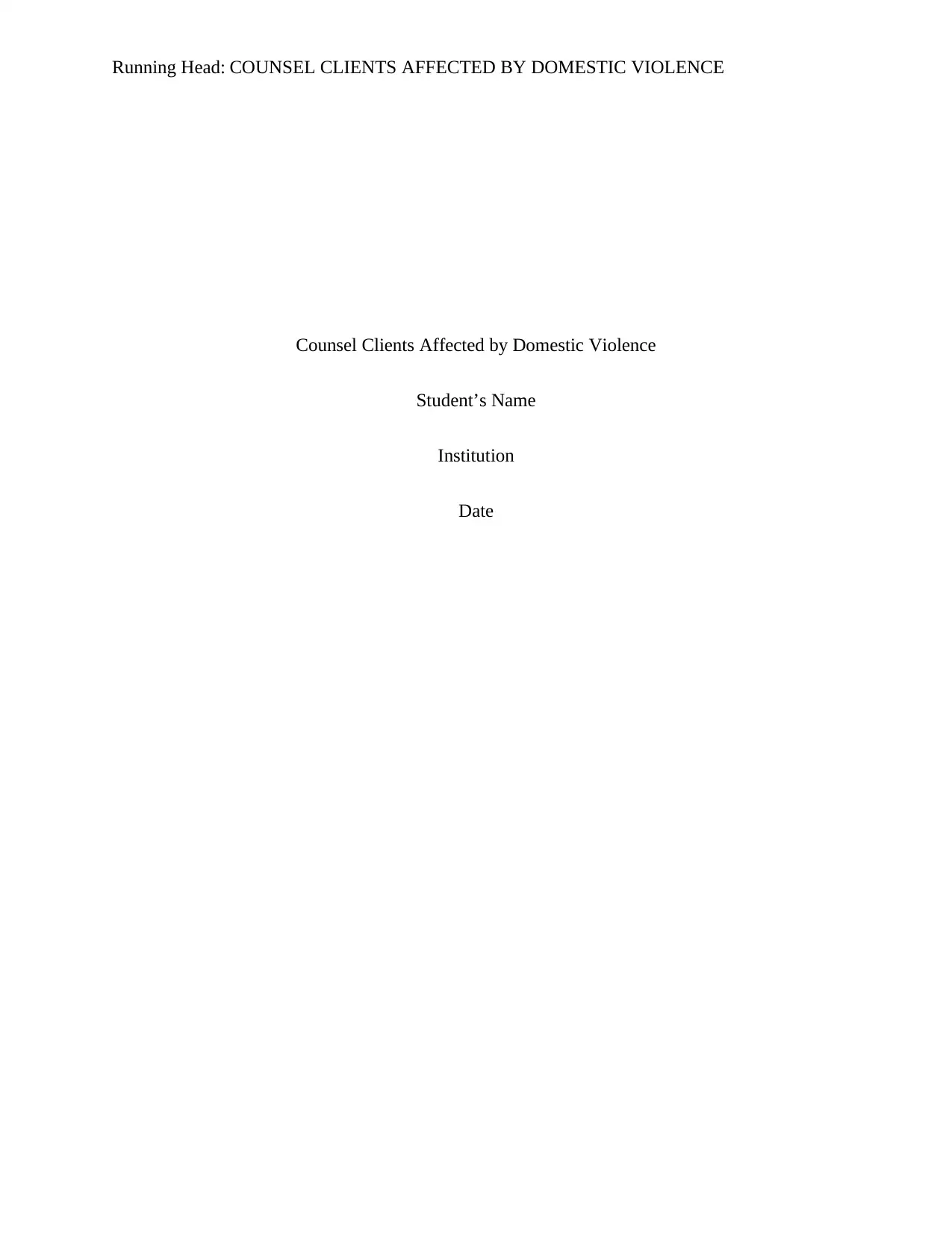
Running Head: COUNSEL CLIENTS AFFECTED BY DOMESTIC VIOLENCE
Counsel Clients Affected by Domestic Violence
Student’s Name
Institution
Date
Counsel Clients Affected by Domestic Violence
Student’s Name
Institution
Date
Paraphrase This Document
Need a fresh take? Get an instant paraphrase of this document with our AI Paraphraser
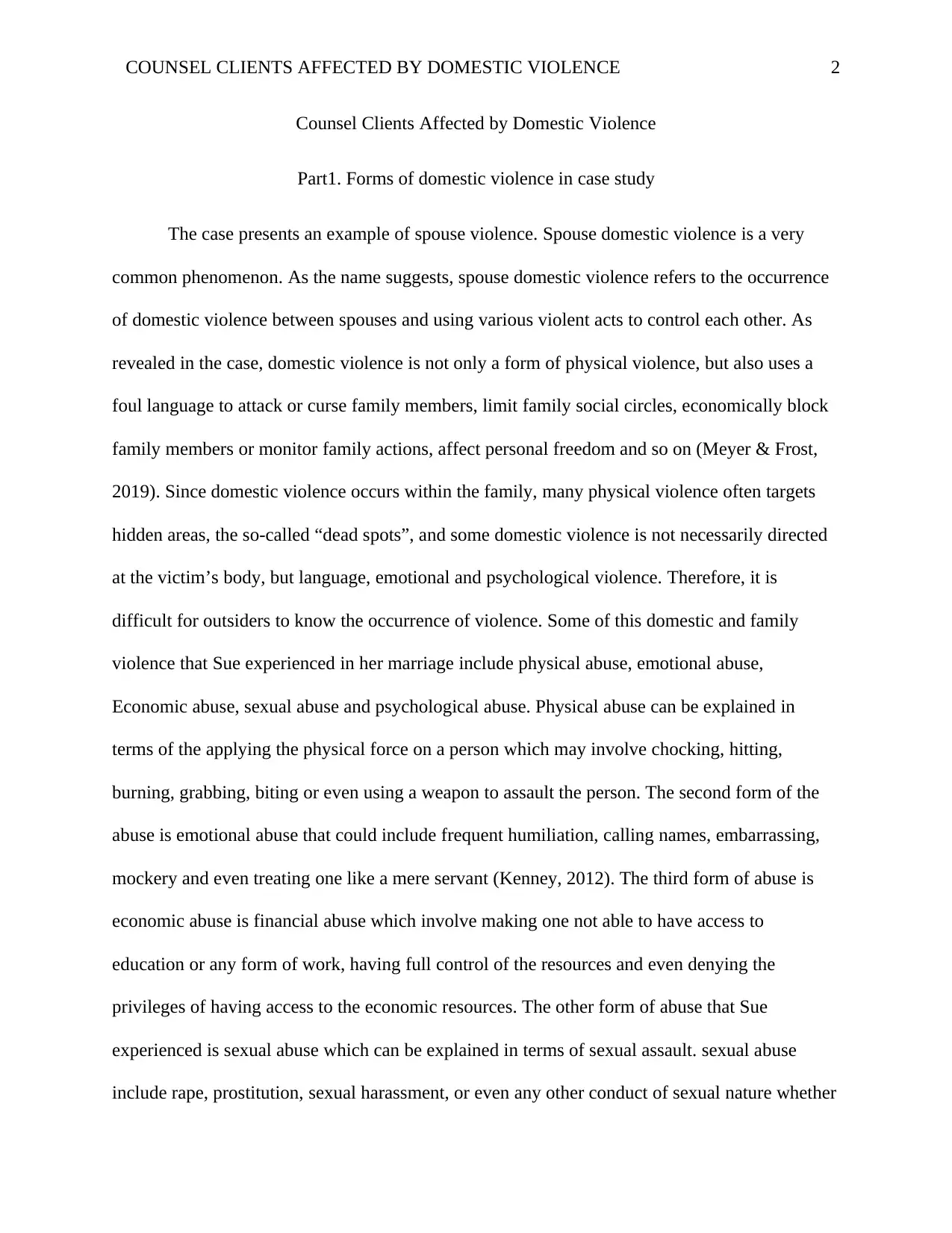
COUNSEL CLIENTS AFFECTED BY DOMESTIC VIOLENCE 2
Counsel Clients Affected by Domestic Violence
Part1. Forms of domestic violence in case study
The case presents an example of spouse violence. Spouse domestic violence is a very
common phenomenon. As the name suggests, spouse domestic violence refers to the occurrence
of domestic violence between spouses and using various violent acts to control each other. As
revealed in the case, domestic violence is not only a form of physical violence, but also uses a
foul language to attack or curse family members, limit family social circles, economically block
family members or monitor family actions, affect personal freedom and so on (Meyer & Frost,
2019). Since domestic violence occurs within the family, many physical violence often targets
hidden areas, the so-called “dead spots”, and some domestic violence is not necessarily directed
at the victim’s body, but language, emotional and psychological violence. Therefore, it is
difficult for outsiders to know the occurrence of violence. Some of this domestic and family
violence that Sue experienced in her marriage include physical abuse, emotional abuse,
Economic abuse, sexual abuse and psychological abuse. Physical abuse can be explained in
terms of the applying the physical force on a person which may involve chocking, hitting,
burning, grabbing, biting or even using a weapon to assault the person. The second form of the
abuse is emotional abuse that could include frequent humiliation, calling names, embarrassing,
mockery and even treating one like a mere servant (Kenney, 2012). The third form of abuse is
economic abuse is financial abuse which involve making one not able to have access to
education or any form of work, having full control of the resources and even denying the
privileges of having access to the economic resources. The other form of abuse that Sue
experienced is sexual abuse which can be explained in terms of sexual assault. sexual abuse
include rape, prostitution, sexual harassment, or even any other conduct of sexual nature whether
Counsel Clients Affected by Domestic Violence
Part1. Forms of domestic violence in case study
The case presents an example of spouse violence. Spouse domestic violence is a very
common phenomenon. As the name suggests, spouse domestic violence refers to the occurrence
of domestic violence between spouses and using various violent acts to control each other. As
revealed in the case, domestic violence is not only a form of physical violence, but also uses a
foul language to attack or curse family members, limit family social circles, economically block
family members or monitor family actions, affect personal freedom and so on (Meyer & Frost,
2019). Since domestic violence occurs within the family, many physical violence often targets
hidden areas, the so-called “dead spots”, and some domestic violence is not necessarily directed
at the victim’s body, but language, emotional and psychological violence. Therefore, it is
difficult for outsiders to know the occurrence of violence. Some of this domestic and family
violence that Sue experienced in her marriage include physical abuse, emotional abuse,
Economic abuse, sexual abuse and psychological abuse. Physical abuse can be explained in
terms of the applying the physical force on a person which may involve chocking, hitting,
burning, grabbing, biting or even using a weapon to assault the person. The second form of the
abuse is emotional abuse that could include frequent humiliation, calling names, embarrassing,
mockery and even treating one like a mere servant (Kenney, 2012). The third form of abuse is
economic abuse is financial abuse which involve making one not able to have access to
education or any form of work, having full control of the resources and even denying the
privileges of having access to the economic resources. The other form of abuse that Sue
experienced is sexual abuse which can be explained in terms of sexual assault. sexual abuse
include rape, prostitution, sexual harassment, or even any other conduct of sexual nature whether
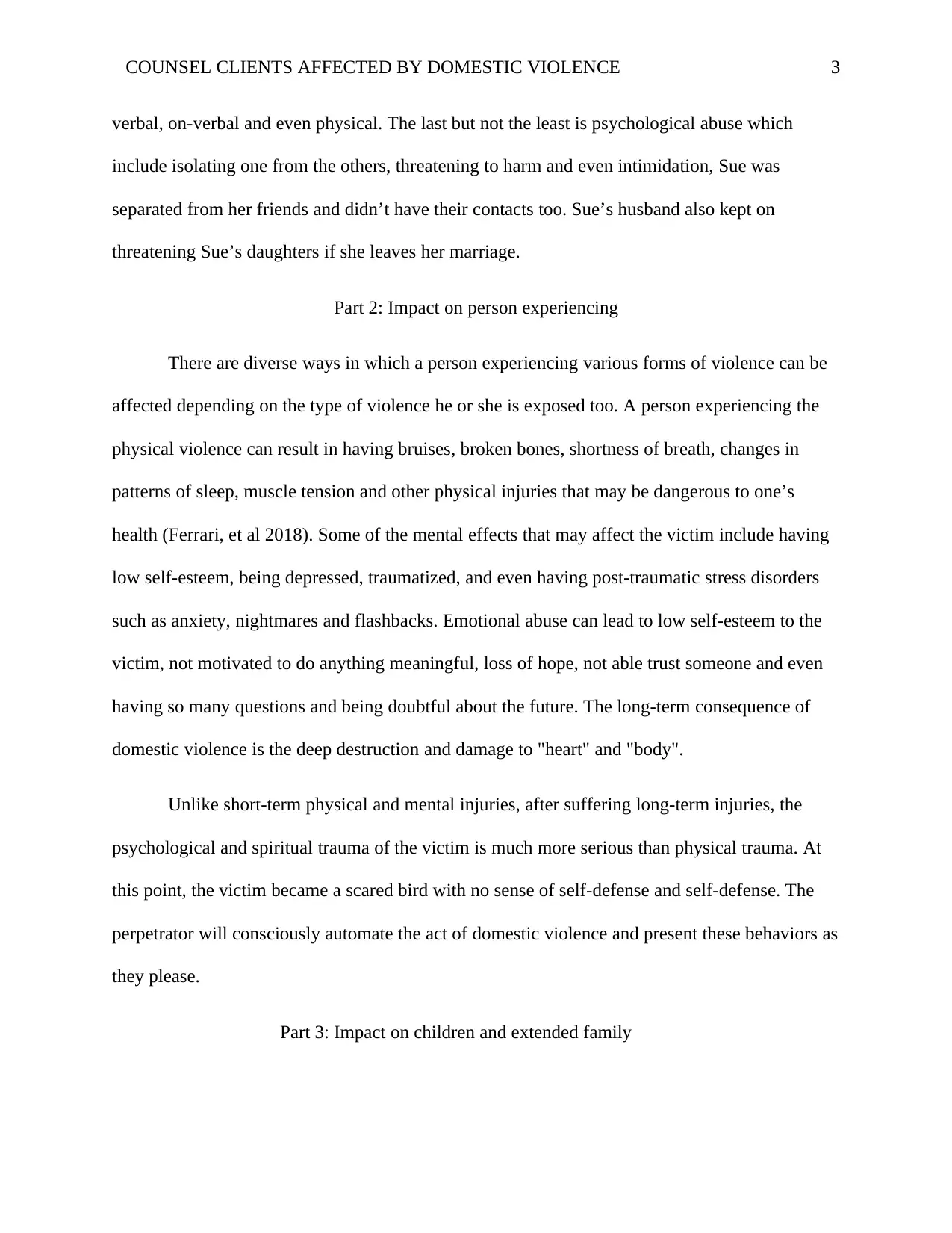
COUNSEL CLIENTS AFFECTED BY DOMESTIC VIOLENCE 3
verbal, on-verbal and even physical. The last but not the least is psychological abuse which
include isolating one from the others, threatening to harm and even intimidation, Sue was
separated from her friends and didn’t have their contacts too. Sue’s husband also kept on
threatening Sue’s daughters if she leaves her marriage.
Part 2: Impact on person experiencing
There are diverse ways in which a person experiencing various forms of violence can be
affected depending on the type of violence he or she is exposed too. A person experiencing the
physical violence can result in having bruises, broken bones, shortness of breath, changes in
patterns of sleep, muscle tension and other physical injuries that may be dangerous to one’s
health (Ferrari, et al 2018). Some of the mental effects that may affect the victim include having
low self-esteem, being depressed, traumatized, and even having post-traumatic stress disorders
such as anxiety, nightmares and flashbacks. Emotional abuse can lead to low self-esteem to the
victim, not motivated to do anything meaningful, loss of hope, not able trust someone and even
having so many questions and being doubtful about the future. The long-term consequence of
domestic violence is the deep destruction and damage to "heart" and "body".
Unlike short-term physical and mental injuries, after suffering long-term injuries, the
psychological and spiritual trauma of the victim is much more serious than physical trauma. At
this point, the victim became a scared bird with no sense of self-defense and self-defense. The
perpetrator will consciously automate the act of domestic violence and present these behaviors as
they please.
Part 3: Impact on children and extended family
verbal, on-verbal and even physical. The last but not the least is psychological abuse which
include isolating one from the others, threatening to harm and even intimidation, Sue was
separated from her friends and didn’t have their contacts too. Sue’s husband also kept on
threatening Sue’s daughters if she leaves her marriage.
Part 2: Impact on person experiencing
There are diverse ways in which a person experiencing various forms of violence can be
affected depending on the type of violence he or she is exposed too. A person experiencing the
physical violence can result in having bruises, broken bones, shortness of breath, changes in
patterns of sleep, muscle tension and other physical injuries that may be dangerous to one’s
health (Ferrari, et al 2018). Some of the mental effects that may affect the victim include having
low self-esteem, being depressed, traumatized, and even having post-traumatic stress disorders
such as anxiety, nightmares and flashbacks. Emotional abuse can lead to low self-esteem to the
victim, not motivated to do anything meaningful, loss of hope, not able trust someone and even
having so many questions and being doubtful about the future. The long-term consequence of
domestic violence is the deep destruction and damage to "heart" and "body".
Unlike short-term physical and mental injuries, after suffering long-term injuries, the
psychological and spiritual trauma of the victim is much more serious than physical trauma. At
this point, the victim became a scared bird with no sense of self-defense and self-defense. The
perpetrator will consciously automate the act of domestic violence and present these behaviors as
they please.
Part 3: Impact on children and extended family
⊘ This is a preview!⊘
Do you want full access?
Subscribe today to unlock all pages.

Trusted by 1+ million students worldwide
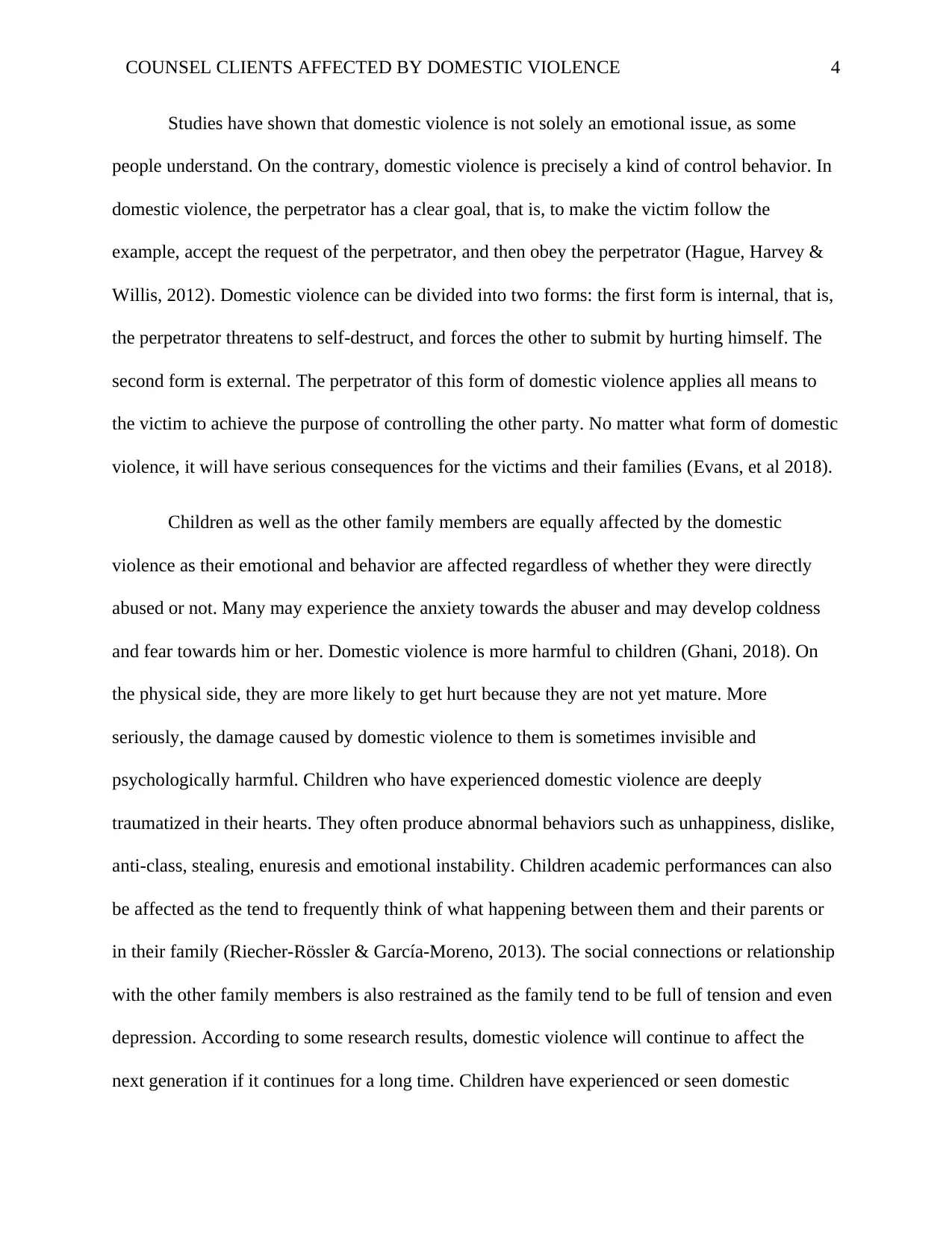
COUNSEL CLIENTS AFFECTED BY DOMESTIC VIOLENCE 4
Studies have shown that domestic violence is not solely an emotional issue, as some
people understand. On the contrary, domestic violence is precisely a kind of control behavior. In
domestic violence, the perpetrator has a clear goal, that is, to make the victim follow the
example, accept the request of the perpetrator, and then obey the perpetrator (Hague, Harvey &
Willis, 2012). Domestic violence can be divided into two forms: the first form is internal, that is,
the perpetrator threatens to self-destruct, and forces the other to submit by hurting himself. The
second form is external. The perpetrator of this form of domestic violence applies all means to
the victim to achieve the purpose of controlling the other party. No matter what form of domestic
violence, it will have serious consequences for the victims and their families (Evans, et al 2018).
Children as well as the other family members are equally affected by the domestic
violence as their emotional and behavior are affected regardless of whether they were directly
abused or not. Many may experience the anxiety towards the abuser and may develop coldness
and fear towards him or her. Domestic violence is more harmful to children (Ghani, 2018). On
the physical side, they are more likely to get hurt because they are not yet mature. More
seriously, the damage caused by domestic violence to them is sometimes invisible and
psychologically harmful. Children who have experienced domestic violence are deeply
traumatized in their hearts. They often produce abnormal behaviors such as unhappiness, dislike,
anti-class, stealing, enuresis and emotional instability. Children academic performances can also
be affected as the tend to frequently think of what happening between them and their parents or
in their family (Riecher-Rössler & García-Moreno, 2013). The social connections or relationship
with the other family members is also restrained as the family tend to be full of tension and even
depression. According to some research results, domestic violence will continue to affect the
next generation if it continues for a long time. Children have experienced or seen domestic
Studies have shown that domestic violence is not solely an emotional issue, as some
people understand. On the contrary, domestic violence is precisely a kind of control behavior. In
domestic violence, the perpetrator has a clear goal, that is, to make the victim follow the
example, accept the request of the perpetrator, and then obey the perpetrator (Hague, Harvey &
Willis, 2012). Domestic violence can be divided into two forms: the first form is internal, that is,
the perpetrator threatens to self-destruct, and forces the other to submit by hurting himself. The
second form is external. The perpetrator of this form of domestic violence applies all means to
the victim to achieve the purpose of controlling the other party. No matter what form of domestic
violence, it will have serious consequences for the victims and their families (Evans, et al 2018).
Children as well as the other family members are equally affected by the domestic
violence as their emotional and behavior are affected regardless of whether they were directly
abused or not. Many may experience the anxiety towards the abuser and may develop coldness
and fear towards him or her. Domestic violence is more harmful to children (Ghani, 2018). On
the physical side, they are more likely to get hurt because they are not yet mature. More
seriously, the damage caused by domestic violence to them is sometimes invisible and
psychologically harmful. Children who have experienced domestic violence are deeply
traumatized in their hearts. They often produce abnormal behaviors such as unhappiness, dislike,
anti-class, stealing, enuresis and emotional instability. Children academic performances can also
be affected as the tend to frequently think of what happening between them and their parents or
in their family (Riecher-Rössler & García-Moreno, 2013). The social connections or relationship
with the other family members is also restrained as the family tend to be full of tension and even
depression. According to some research results, domestic violence will continue to affect the
next generation if it continues for a long time. Children have experienced or seen domestic
Paraphrase This Document
Need a fresh take? Get an instant paraphrase of this document with our AI Paraphraser
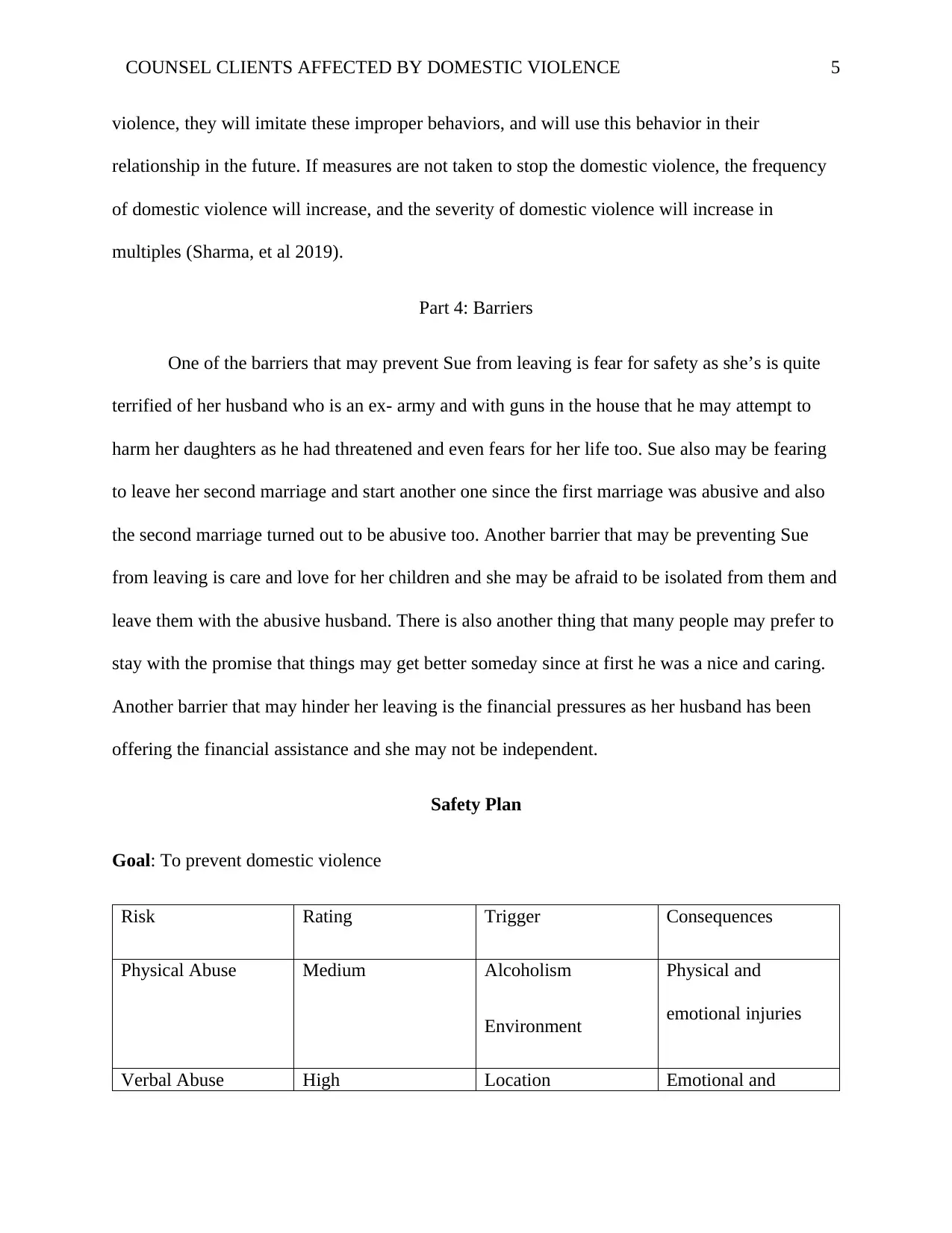
COUNSEL CLIENTS AFFECTED BY DOMESTIC VIOLENCE 5
violence, they will imitate these improper behaviors, and will use this behavior in their
relationship in the future. If measures are not taken to stop the domestic violence, the frequency
of domestic violence will increase, and the severity of domestic violence will increase in
multiples (Sharma, et al 2019).
Part 4: Barriers
One of the barriers that may prevent Sue from leaving is fear for safety as she’s is quite
terrified of her husband who is an ex- army and with guns in the house that he may attempt to
harm her daughters as he had threatened and even fears for her life too. Sue also may be fearing
to leave her second marriage and start another one since the first marriage was abusive and also
the second marriage turned out to be abusive too. Another barrier that may be preventing Sue
from leaving is care and love for her children and she may be afraid to be isolated from them and
leave them with the abusive husband. There is also another thing that many people may prefer to
stay with the promise that things may get better someday since at first he was a nice and caring.
Another barrier that may hinder her leaving is the financial pressures as her husband has been
offering the financial assistance and she may not be independent.
Safety Plan
Goal: To prevent domestic violence
Risk Rating Trigger Consequences
Physical Abuse Medium Alcoholism
Environment
Physical and
emotional injuries
Verbal Abuse High Location Emotional and
violence, they will imitate these improper behaviors, and will use this behavior in their
relationship in the future. If measures are not taken to stop the domestic violence, the frequency
of domestic violence will increase, and the severity of domestic violence will increase in
multiples (Sharma, et al 2019).
Part 4: Barriers
One of the barriers that may prevent Sue from leaving is fear for safety as she’s is quite
terrified of her husband who is an ex- army and with guns in the house that he may attempt to
harm her daughters as he had threatened and even fears for her life too. Sue also may be fearing
to leave her second marriage and start another one since the first marriage was abusive and also
the second marriage turned out to be abusive too. Another barrier that may be preventing Sue
from leaving is care and love for her children and she may be afraid to be isolated from them and
leave them with the abusive husband. There is also another thing that many people may prefer to
stay with the promise that things may get better someday since at first he was a nice and caring.
Another barrier that may hinder her leaving is the financial pressures as her husband has been
offering the financial assistance and she may not be independent.
Safety Plan
Goal: To prevent domestic violence
Risk Rating Trigger Consequences
Physical Abuse Medium Alcoholism
Environment
Physical and
emotional injuries
Verbal Abuse High Location Emotional and
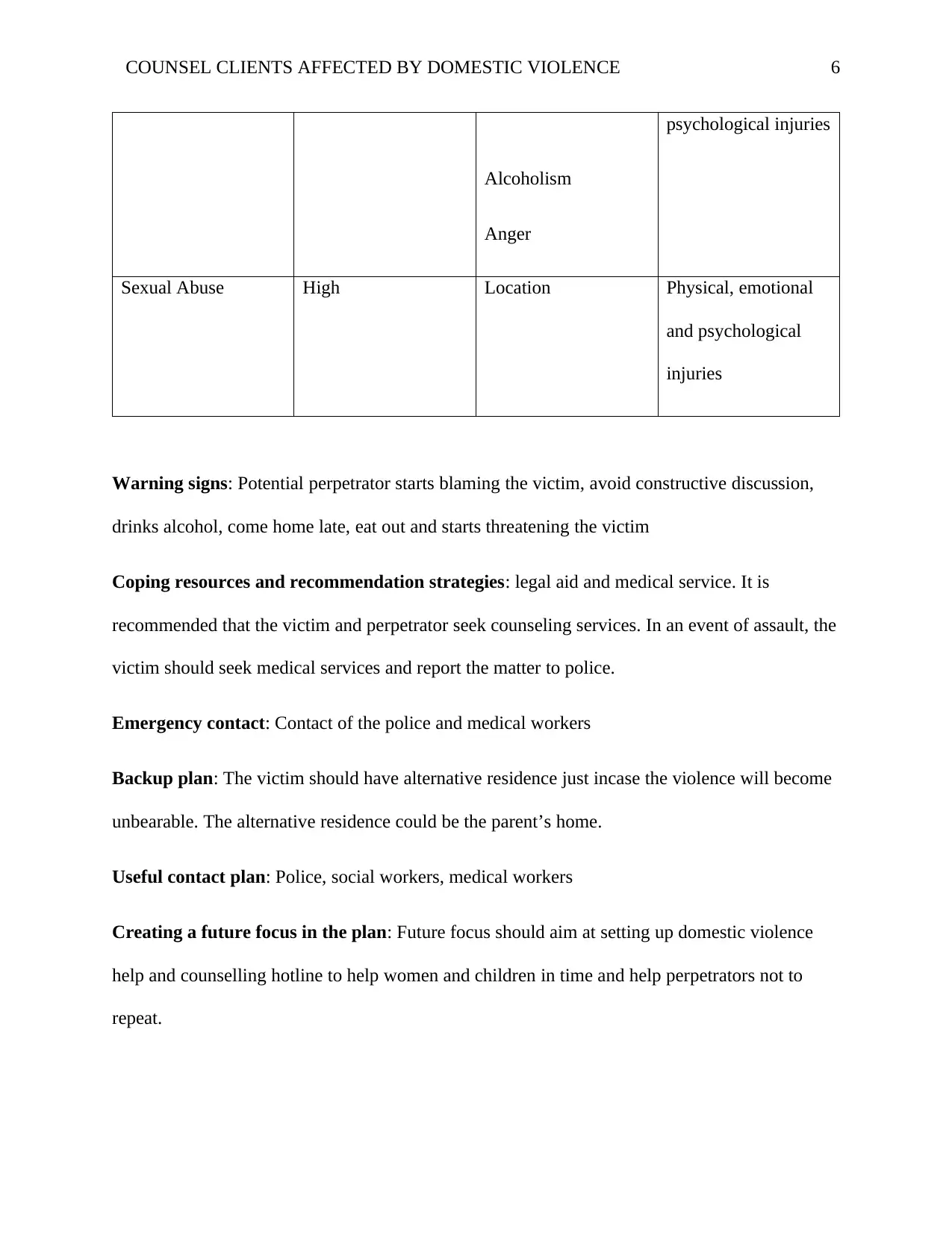
COUNSEL CLIENTS AFFECTED BY DOMESTIC VIOLENCE 6
Alcoholism
Anger
psychological injuries
Sexual Abuse High Location Physical, emotional
and psychological
injuries
Warning signs: Potential perpetrator starts blaming the victim, avoid constructive discussion,
drinks alcohol, come home late, eat out and starts threatening the victim
Coping resources and recommendation strategies: legal aid and medical service. It is
recommended that the victim and perpetrator seek counseling services. In an event of assault, the
victim should seek medical services and report the matter to police.
Emergency contact: Contact of the police and medical workers
Backup plan: The victim should have alternative residence just incase the violence will become
unbearable. The alternative residence could be the parent’s home.
Useful contact plan: Police, social workers, medical workers
Creating a future focus in the plan: Future focus should aim at setting up domestic violence
help and counselling hotline to help women and children in time and help perpetrators not to
repeat.
Alcoholism
Anger
psychological injuries
Sexual Abuse High Location Physical, emotional
and psychological
injuries
Warning signs: Potential perpetrator starts blaming the victim, avoid constructive discussion,
drinks alcohol, come home late, eat out and starts threatening the victim
Coping resources and recommendation strategies: legal aid and medical service. It is
recommended that the victim and perpetrator seek counseling services. In an event of assault, the
victim should seek medical services and report the matter to police.
Emergency contact: Contact of the police and medical workers
Backup plan: The victim should have alternative residence just incase the violence will become
unbearable. The alternative residence could be the parent’s home.
Useful contact plan: Police, social workers, medical workers
Creating a future focus in the plan: Future focus should aim at setting up domestic violence
help and counselling hotline to help women and children in time and help perpetrators not to
repeat.
⊘ This is a preview!⊘
Do you want full access?
Subscribe today to unlock all pages.

Trusted by 1+ million students worldwide

COUNSEL CLIENTS AFFECTED BY DOMESTIC VIOLENCE 7
Paraphrase This Document
Need a fresh take? Get an instant paraphrase of this document with our AI Paraphraser
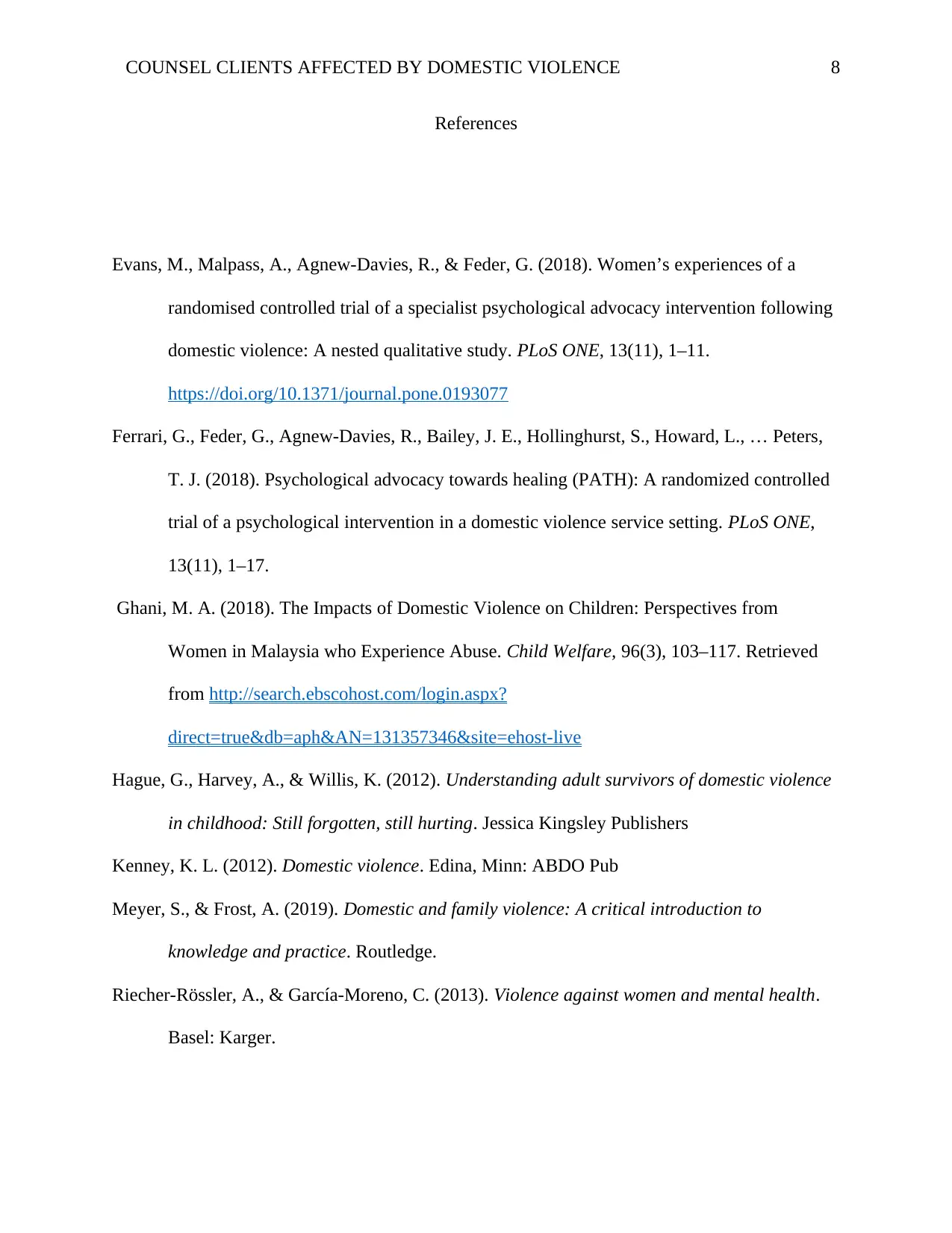
COUNSEL CLIENTS AFFECTED BY DOMESTIC VIOLENCE 8
References
Evans, M., Malpass, A., Agnew-Davies, R., & Feder, G. (2018). Women’s experiences of a
randomised controlled trial of a specialist psychological advocacy intervention following
domestic violence: A nested qualitative study. PLoS ONE, 13(11), 1–11.
https://doi.org/10.1371/journal.pone.0193077
Ferrari, G., Feder, G., Agnew-Davies, R., Bailey, J. E., Hollinghurst, S., Howard, L., … Peters,
T. J. (2018). Psychological advocacy towards healing (PATH): A randomized controlled
trial of a psychological intervention in a domestic violence service setting. PLoS ONE,
13(11), 1–17.
Ghani, M. A. (2018). The Impacts of Domestic Violence on Children: Perspectives from
Women in Malaysia who Experience Abuse. Child Welfare, 96(3), 103–117. Retrieved
from http://search.ebscohost.com/login.aspx?
direct=true&db=aph&AN=131357346&site=ehost-live
Hague, G., Harvey, A., & Willis, K. (2012). Understanding adult survivors of domestic violence
in childhood: Still forgotten, still hurting. Jessica Kingsley Publishers
Kenney, K. L. (2012). Domestic violence. Edina, Minn: ABDO Pub
Meyer, S., & Frost, A. (2019). Domestic and family violence: A critical introduction to
knowledge and practice. Routledge.
Riecher-Rössler, A., & García-Moreno, C. (2013). Violence against women and mental health.
Basel: Karger.
References
Evans, M., Malpass, A., Agnew-Davies, R., & Feder, G. (2018). Women’s experiences of a
randomised controlled trial of a specialist psychological advocacy intervention following
domestic violence: A nested qualitative study. PLoS ONE, 13(11), 1–11.
https://doi.org/10.1371/journal.pone.0193077
Ferrari, G., Feder, G., Agnew-Davies, R., Bailey, J. E., Hollinghurst, S., Howard, L., … Peters,
T. J. (2018). Psychological advocacy towards healing (PATH): A randomized controlled
trial of a psychological intervention in a domestic violence service setting. PLoS ONE,
13(11), 1–17.
Ghani, M. A. (2018). The Impacts of Domestic Violence on Children: Perspectives from
Women in Malaysia who Experience Abuse. Child Welfare, 96(3), 103–117. Retrieved
from http://search.ebscohost.com/login.aspx?
direct=true&db=aph&AN=131357346&site=ehost-live
Hague, G., Harvey, A., & Willis, K. (2012). Understanding adult survivors of domestic violence
in childhood: Still forgotten, still hurting. Jessica Kingsley Publishers
Kenney, K. L. (2012). Domestic violence. Edina, Minn: ABDO Pub
Meyer, S., & Frost, A. (2019). Domestic and family violence: A critical introduction to
knowledge and practice. Routledge.
Riecher-Rössler, A., & García-Moreno, C. (2013). Violence against women and mental health.
Basel: Karger.

COUNSEL CLIENTS AFFECTED BY DOMESTIC VIOLENCE 9
Sharma, K., Vatsa, M., Kalaivani, M., & Bhardwaj, D. (2019). Mental health effects of domestic
violence against women in Delhi: A community-based study. Journal of Family
Medicine & Primary Care, 8(7), 2522–2527. https://doi.org/10.4103/jfmpc.jfmpc_427
Sharma, K., Vatsa, M., Kalaivani, M., & Bhardwaj, D. (2019). Mental health effects of domestic
violence against women in Delhi: A community-based study. Journal of Family
Medicine & Primary Care, 8(7), 2522–2527. https://doi.org/10.4103/jfmpc.jfmpc_427
⊘ This is a preview!⊘
Do you want full access?
Subscribe today to unlock all pages.

Trusted by 1+ million students worldwide
1 out of 9
Related Documents
Your All-in-One AI-Powered Toolkit for Academic Success.
+13062052269
info@desklib.com
Available 24*7 on WhatsApp / Email
![[object Object]](/_next/static/media/star-bottom.7253800d.svg)
Unlock your academic potential
Copyright © 2020–2025 A2Z Services. All Rights Reserved. Developed and managed by ZUCOL.





